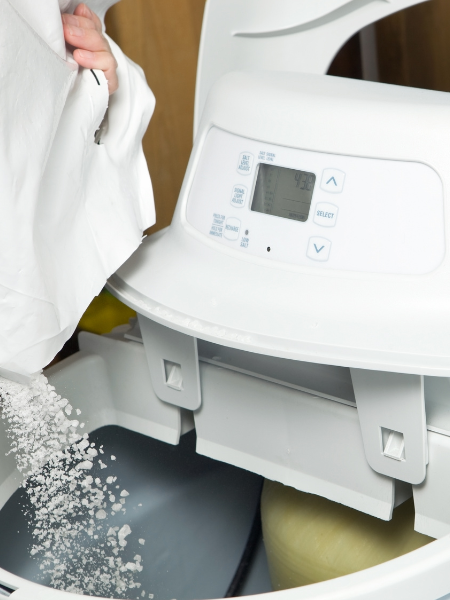Water softeners can be installed in homes to remove minerals such as calcium and magnesium from the water supply. These minerals cause hard water, leaving a chalky residue on fixtures and appliances and causing a range of domestic and hygienic issues.
We’ve already talked about why installers should talk to customers about water softeners in a previous blog, but in short - water softeners are devices installed under the sink at the main water supply, which will improve the quality of household water, making it softer, cleaner, and more enjoyable, particularly if your client lives in a hard water area.
Our experts have compiled a helpful step-by-step guide on how to install a Water Softener for your customers, helping them minimise bills and enhance household efficiency.
Best water softeners for homes
Installing a water softener is a straightforward procedure that can be done by a professional plumber. First and foremost, we must identify what Water Softener best suits your customer’s individual needs and preferences. There are four common types of Water Softeners available on the market;
- Salt-based water softeners - are the most standard type of water softeners. They use an ion exchange method to remove pollutants such as magnesium and calcium from the water, which can cause hard water.
- Salt-free water softeners - Salt-free water softeners use a different process called template-assisted crystallization (TAC) which binds the minerals together to easily remove them from the water just like the Calmag CalTAC range - this is a softener alternative that uses TAC to cope with 32 litres per minute.
- Dual-tank softeners - Dual-tank softeners have two tanks, one for the brine and one for the resin. They are a good option for homeowners with high water usage, as this softener regenerates more quickly than single-tank water softeners.
- Magnetic water softeners - Will change the molecular structure of the minerals in your water using the magnets inside, making them less likely to stick to your fixtures and appliances. They are less practical than salt-based or salt-free water softeners, but they are a good choice for consumers who are looking for a maintenance-free water softener.

WRAS approved products
WRAS is the approval that allows the installation of products to carry or receive water from the public mains water supply in the UK. It is vital that the manufacturer of the water softener adheres to working with the Water Regulations Advisory Scheme (WRAS) and provides documentation that can be understood by installers.
Plumbers guide to installing Water Softeners
Once you know what type of water softener you will install for the homeowner, you can start installation. First, ensure there is enough space underneath the kitchen sink for the water softener to fit into.
Some water softeners may require their own power supply, so check to ensure there is a free socket close to where the softener will be installed.
If you are installing a water softener in a property for the first time, then they probably will only have a cold water stop-cock, which will run up through the metre and then up to the taps.
It is recommended to also fit a dedicated cold water supply up to the kitchen tap so only the softened water gets distributed around the house and not out of the fixtures, as some customers prefer not to drink softened water. It will also prevent any disruption to the customer's water supply, in the instance you need to quickly isolate the water softener if any faults occur.

Installing a Water Softener: Step by step
- Switch off the mains water supply.
- Turn on the taps to drain any remaining water.
- Water Softeners will have an overflow for the brine chamber on the back, so you will need to measure up and drill a hole through the external wall.
- Install the bypass valve onto the water softener. As mentioned, you can redirect the water flow without cutting off the supply to your entire house if the water softener needs servicing.
- Connect the discharger, inlet and outlet hoses to the water softener. It's important to note that most water softeners will not come with hoses but rest assured, we have hoses available to purchase.
Once everything has been fitted you can turn on the water supply again. Make sure that the bypass valve is closed and that the inlet and outlet valves are both open. It's worth checking around for any leaks to ensure the system is working and is sound.
Water Softener Maintenance
Once you’ve installed the water softener for your customer, it’s equally important to help guide them on water softener maintenance to keep it working as effectively and efficiently as possible for years to come.
There are a few things that can increase the longevity of the softener, such as;
- Regularly checking salt levels
If the salt level gets too low, the softener will not be able to remove minerals as effectively. It is recommended to inspect the salt level at least once a month.
- Regenerate the water softener regularly.
A water softener's regeneration cycle allows for effectively removing minerals from the resin beads.
- Clean the brine tank.
The brine tank is where the salt is stored. It is essential to clean the brine tank to stop any buildup of sediment and salt bridges.
- Flush the water softener regularly.
Flushing the water softener out will help to dispose of any minerals that may have been collected in the system.

If you require more expert advice then get in touch or contact your local City Plumbing branch. We have a vast variety of Water Softeners - with next day delivery options available.
If you are an installer then why not read about Britain's Limescale Problem - with a forward-thinking solution in order for consumers to save money and increase long-term sustainability.
Our experts are an installer’s secret weapon for navigating the latest and greatest in water treatment technology.
Other articles

Smart Security: How installers can make homeowners feel more secure
31 Jul 2023 ・ 4 mins

How to spot a water leak - 10 easy ways
17 Jul 2023 ・ 7 mins

What is a boiling water tap?
22 Mar 2022 ・ 4 mins



